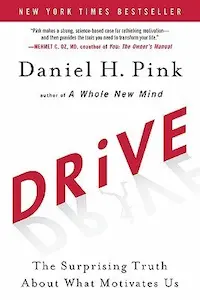Drive - Summary
Daniel H. Pink

Introduction
In his book “Drive: The Surprising Truth About What Motivates Us,” Daniel H. Pink explores the concept of motivation and challenges traditional thinking about what drives human behavior. Drawing on extensive research and real-life examples, Pink argues that intrinsic motivation, rather than external rewards or punishments, is the key to unlocking our true potential and achieving long-term satisfaction and success.
The Three Elements of Intrinsic Motivation
Pink introduces three essential elements that contribute to intrinsic motivation: autonomy, mastery, and purpose. Autonomy refers to the desire to direct our own lives, make choices, and have control over our work. Mastery is the urge to get better at something that matters to us, constantly improving our skills and knowledge. Finally, purpose is the yearning to be part of something bigger than ourselves, to contribute to a meaningful cause.
Autonomy: The Drive for Self-Directedness
According to Pink, individuals are motivated when they have a sense of autonomy and are given the freedom to make decisions. He shares examples from various companies, such as Google and Atlassian, where employees are encouraged to spend a portion of their time pursuing personal projects. This autonomy not only increases job satisfaction but also leads to innovative ideas and breakthroughs.
Mastery: The Pursuit of Excellence
Pink emphasizes the importance of mastery in driving motivation. He discusses the concept of “flow,” a state of deep engagement and focus, where individuals are fully immersed in their work. He cites the example of the video game industry, where players willingly spend countless hours perfecting their skills and overcoming challenges. Pink suggests that by fostering an environment that encourages continuous learning and growth, organizations can tap into individuals’ intrinsic motivation to achieve mastery.
Purpose: Beyond Profit
While financial incentives may provide short-term motivation, Pink argues that a sense of purpose is what truly drives individuals in the long run. He presents examples of companies like TOMS, a shoe company that donates a pair of shoes for every pair sold, and Zappos, an online retailer that prioritizes customer satisfaction. These organizations have successfully aligned their purpose with their business goals, attracting dedicated employees and loyal customers.
The Role of Rewards and Punishments
Contrary to popular belief, Pink challenges the effectiveness of traditional rewards and punishments in motivating individuals. He explains that while rewards can provide a temporary boost in motivation, they often lead to a decrease in intrinsic motivation over time. Pink highlights studies that demonstrate how extrinsic rewards can undermine creativity and problem-solving abilities. Instead, he suggests that organizations focus on creating an environment that nurtures intrinsic motivation.
The Power of Autonomy Supportive Environments
Pink emphasizes the importance of autonomy-supportive environments in fostering intrinsic motivation. He suggests that leaders should focus on providing individuals with a sense of autonomy, offering meaningful feedback, and allowing for self-direction. Pink cites the example of ROWE (Results-Only Work Environment), where employees are evaluated based on outcomes rather than the number of hours worked. This approach not only increases productivity but also enhances job satisfaction and work-life balance.
Strategies for Cultivating Intrinsic Motivation
Pink provides practical strategies for individuals and organizations to cultivate intrinsic motivation. He suggests allowing employees to have more control over their work, providing opportunities for skill development and growth, and aligning work with a larger purpose. Pink also emphasizes the importance of intrinsic motivation in education, advocating for student-centered learning approaches that promote autonomy, mastery, and purpose.
Conclusion
In “Drive,” Daniel H. Pink challenges traditional notions of motivation and presents a compelling case for the power of intrinsic motivation. By fostering autonomy, mastery, and purpose, individuals and organizations can tap into their true potential and achieve greater satisfaction and success. Pink’s research and real-life examples demonstrate that intrinsic motivation is the key to unlocking creativity, innovation, and long-term engagement. By embracing the principles outlined in “Drive,” we can create environments that inspire and motivate individuals to reach new heights.